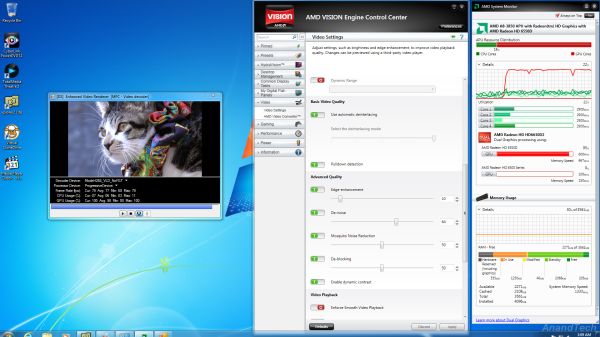AMD A8-3850 : An HTPC Perspective
by Ganesh T S on June 30, 2011 6:20 AM ESTDXVA Checker indicates the various capabilities of the AMD6550D, as exposed by the drivers.
The only puzzling aspect is the missing ModeH264MVC_VLD_Avivo entry which is present in the AMD 6xxx cards with UVD3. Instead, we have ModeH264_VLD_Multiview_Avido, which means that the Blu-ray players will have to interface with this new entry. AMD let us know that the 6550D doesn't have full hardware acceleration for 3D Blu-Rays. Some sort of extra assistance from the host CPU will be needed.
Our grouse with the low end AMD GPUs like the 6450 and 5450 was the fact that they were not certified for 1080p60 H.264 playback. Instead, they confined themselves to Blu-ray specs. With the advent of camcorders capable of 1080p60 recording, we believe this restriction should not be in place. What about the AMD 6550D?
We fired up DXVA Checker, and tried to benchmark a 1080p60 clip from a camcorder.
With all post processing steps enabled, I was pleased to find that the clip benchmarked at 77 fps, well beyond the 60 fps necessary to avoid frame drops.
With full hope, I tried playing back the clip in MPC-HC. As it turned out, approximately half the frames were dropped with ESVP on. Manually disabling all post processing options enabled us to play back the clip without frame drops (except for the initial startup trouble).
The discrepancy between DXVA Checker and MPC-HC was a surprise. They tallied without issues when we were benchmarking the discrete GPUs earlier this month. Either DXVA Checker or MPC-HC has problems with the AMD 3550D, and hence, we decided not to carry out the FPS benchmark for various codecs.
According to AMD, Blu-ray content shouldn't have any such issues. We took a 1080i60 clip from a Blu-ray (M2TS file) and tried playing it back in PowerDVD. Unfortunately, it looks like nothing other than Vector Adaptive (VA) deinterlacing is available, as shown in the gallery below.
In our opinion, it is not good for mainstream integrated GPUs to skimp on video post processing for Blu-ray videos itself.
All in all, even without running the DXVA benchmark, we have encountered a host of issues in playing back files at their native frame rate. Once the drivers get mature and the discrepancy between MPC-HC and DXVA Checker get resolved, we will probably revisit this. But, we wouldn't be surprised if AMD puts up its hands and says that the unit's functionality and performance are as per expectations.

















104 Comments
View All Comments
patsfan - Sunday, July 10, 2011 - link
I have read, off and on for the last 7 years or so articles on Anandtech, however, the ONLY reason I come here anymore is the same reason I look at CNN from time to time. For a good laugh. What started off as a fairly serious website for reviews on all things peripheral, has now turned into an INTEL propaganda machine. Seriously, when you look at all the ads, all you see is INTEL, INTEL, INTEL. Anand, if you stepped back and looked at your website as it gets pulled up, you would see what we see, a website that is no longer objective, between Intel, and Crapple you've apparently lost your objective way. I look at the obvious, AMD is the underdog, and I'll pick the underdog every time, and as far as Apple goes, it's a hell of a marketing machine, but as far as equipment goes???? The I-phone was great 4 years ago, today, it is mediocre at best, and if you're into power computing, Apple has absolutely NO compelling entry. Sadly, I resign myself to the fact that this website no longer provides me with any stimulating information, other than being an Intel/Crapple bully pulpit........ Oh wellqqgoodhao - Sunday, July 17, 2011 - link
http://www.ifancyshop.comWomen's fashion, men's personality + shoes
Travel bagthat eye-catching jacket + super pack free shipping
zgoodbbb - Wednesday, July 20, 2011 - link
http://www.ifancyshop.comWomen's fashion, men's personality + shoes
Travel bagthat eye-catching jacket + super pack free shipping
morohmoroh - Friday, July 22, 2011 - link
puting northbrigde inside core CPU is wonderfull in age of 32 NM but than ....that GPU radeon is still shared ram outside the processor , and NB still have to hop in out to transfer data in and out from the socket .....and it shared too with other kinda data for system stored at ram socket ddr3discreet VGA have dedicated RAM and some indenpendet core CPU too like in Nvidia , i wondering GDDR5 VS DDR3 , which one is fastes speedt?........comboing VGA is another idea but all that handle via software not at hardware it self.... so far see there is just another decoder for movies aka films format
the northbridge itself inside or outside core CPU will stressing alot hardwork to transforming coming in out data from external socket RAM....and i think it will produce more heat itself at the core
how can NB self handle 64 Gigs? i read that phenom x6 are gonna be very hot to handle 16 Gigs
intel create DMI to handle data boost at Mobos ram pci etc ...and QPI for inner core data boost...
well i not preety sure 32 Nm liano architecture are work fines in real wordl practically electron flows handling data , speed etc.....and mobo compability to manage the potential of it
pushing external DDR3 speed to act like GDDR5 for integrated VGA on same dies core ?
and i dont really care about i3 etc with VGA too i think its just another variaton for marketing thats all..seem nothing significant inovation about nano tech age can do more beyond that...
maybe doctor OCt gonna say "the power of the sun in palm of my hand "LOL
cheers